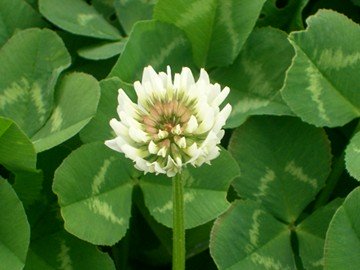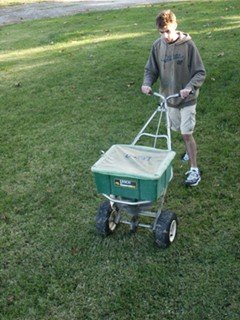All About Lawn Weeds

Lawn weeds can be one of the more troubling aspects of lawn care. Most weeds are opportunistic and will take advantage of any weakness in the turf. Thinner areas of grass, grass that is mowed too short and even infertile soil make perfect opportunities for weeds to grow.
Weeds compete with grass for space, nutrients and water. Many weeds grow much faster than turfgrass and can quickly get out of control if measures are not taken to stop them. At the very least, they detract from the quality and appearance of your lawn.
Important Fact About Lawn Weeds
The conditions that allowed for weeds to flourish must be corrected
or they will continually be a problem. You can kill the weeds all you want, but if you do nothing else, they will return.
Lawns must be maintained in a way that promotes a healthy lawn, while discouraging lawn weeds. There are many ways to accomplish this. For example, some types of grasses can be overseeded to thicken the turf.

It is important develop a sound fertilization program based on the needs and use of the grass. This will help promote a vigorous lawn.
Adding fertilizer to a weedy lawn will give you healthy weeds. You will need to incorporate a weed control program to your fertilization program. Overseeding, aeration and other maintenance activities may be needed in the beginning especially to promote the best lawn possible.
For most grasses, it better to mow the lawn at the highest recommended level. This is especially important for cool season grasses. These tactics will hinder weed germination and growth since most weeds cannot compete easily with a thick lawn.
If the lawn is in serious decline, it may take a couple of years to develop a quality turf and see a major reduction in weed growth. There are not too many shortcuts to producing a nice lawn. For the most part, the methods are the same for homeowners and professionals alike.
The last resort for weed control is to use chemical herbicides. However, as lawn quality improves, lawn weeds and herbicide use will be greatly reduced.
Important Note on Grassy Weed and Herbicides
A commonly asked question is how to kill weeds. The answer contains both good news and bad news.
The good news: Most broadleaf lawn weeds can easily be controlled by a variety of herbicides.
The bad news: This is not the case with some grassy weeds.
There are fewer selective herbicides capable of controlling grassy weeds. Grassy weeds are classified as undesirable grasses, however they are genetically similar to
desirable grasses.
Since many desirable grasses and grassy weeds are genetically similar, there are fewer herbicides that can effectively control one type of grass without harming other types.
Fortunately, some of the more common grassy weeds, including crabgrass, foxtails and sedges can be controlled using selective herbicides.
Always read and follow herbicide label instructions completely.
Weed Classifications
A weed is classified as any plant that is growing where it is not wanted. Even turfgrasses can be considered a weed when they have spread into planters or into neighboring yards.
The two main weed categories are
- broadleaf weeds (dicots)
- grassy weeds (monocots)
- Sedges
When these plants first emerge from the soil after germination, monocots will emerge as a single blade while dicots emerge from the soil with two blades.
There is also another group of lawn weeds called “sedges” that are related to grasses. These look very similar to grasses, but are easily distinguished by their triangular stems.
The broadleaf weed category contains some of the most commonly recognized weed types. Within this group are plants such as dandelions, plantains, chickweed, clover and many other species.
Grassy weeds contain some of the more difficult weeds to control. They include annual bluegrass, crabgrass, foxtails, goosegrass, nimblewill, barnyard grass and sandbur, to name just a few.
The small groups of sedges contain a few varieties such as purple nutsedge, yellow nutsedge and also hurricane grass.
Annual and Perennial Weed Types
Many weeds are annuals and have a one year life cycle. This means they will germinate from seed, mature and die within twelve months. There are summer annuals and winter annuals.
Winter annuals will germinate from seed in the fall and survive the winter in a seedling or young grass state. They resume growth in the spring producing many seeds then die as the air and soil temperatures heat up in late spring or early summer. Annual bluegrass, common chickweed, and henbit are examples of winter annuals.
Summer annuals will germinate from seed in late spring, mature and die in the fall with the first killing frost. Crabgrass, sandbur, black medic, prostrate spurge and carpetweed are examples of summer annuals.
Since annuals die each year their survival depends on the seed produced the previous year. Most annuals produce large volumes of tiny seed. These small seeds are easily blown and worked into the soil.
With perennial weeds, their survival is attributed to well developed root systems, rhizomes and stolon production, or seed. Some weeds will use a combination of all three.
Many weeds are very capable of growing in highly compacted, rocky or nutrient depleted soils. They can survive under conditions that would kill other plant life.
Weeds Incredible Survival Techniques
This will help explain why doing nothing about weeds will only guarantee their survival.
Many weeds have very unique methods of ensuring their continued existence. Oxalis (Yellow Wood Sorrel), for example, produces seed pods that explode when they are touched, spraying very tiny seeds for several feet in all directions.
Dandelion tap roots can extend a foot into the soil. Not only that, but even if you cut the root into a dozen pieces and plant each piece, they would produce a dozen new dandelion plants. This means, if you attempt to rid your lawn of dandelions by pulling them up by hand, any portion of the root left in the soil can produce a new plant.
Quackgrass is a grassy weed that emits chemicals from its roots that harms the other plants around it. This helps quackgrass to get established and gain the upper hand. These and other unique qualities of lawn weeds. These are part of the reason lawn weeds are so common.
How the Weed Links Below Can Help You
If getting rid of weeds is your primary focus, then the pages in this lawn weed section will help you identify common lawn weeds and the best methods of controlling them. When you remember about 75% of weed control is non-chemical, it makes weed control much safer and easier in the long run. Cultural practices that emphasize a thick, vigorous turf will leave little room for many weeds to germinate and grow.
Crabgrass and Foxtails- Annual Grassy Weeds
Crabgrass and Foxtails are two major annual weeds that can cover
your lawn. You will find detailed information on their growth habits and
how to stop them before they even start.
Winter Annual Broadleaf Weeds
With each spring comes a surge of winter annual weeds. Here you will
find valuable information about these difficult weeds including growth
habits, photos, and measures that can be taken to control them.
Summer Annual Broadleaf Weeds
Many of the most problematic lawn weeds are annuals. Here you will
find specific summer annual weed information, with weed names, photos
and control methods.
Perennial Broadleaf Weed Identification Page 1
Click here for weed identification and control of common perennial lawn weeds. This page has detailed information on Canada Thistle, Mouseear Chickweed, White clover, Dandelion, Field Bindweed, Ground Ivy, and Common Mallow.
Perennial Broadleaf Weed Identification Page 2
Click here for perennial weed identification and control. You can find detailed information on Buckhorn Plantain, Broadleaf Plantain, Red Sorrel, Wild Violets, and Common Yarrow.
Yellow and Purple Nutsedge
Nutsedge is a summer perennial grass-like weed. They can be
particular problematic since they cannot be controlled by broadleaf weed
herbicides. Click here for weed identification, growth habits and
control methods.
Wild Onions and Wild Garlic
Wild onions and wild garlic are common perennial lawn weeds. They
are early season weeds that grow faster than the surrounding grass and
can be a persistent problem. Find out how to get rid of them for good.
Lawn Weeds page to Lawn Care Academy Home
Share This page:

For Specific Weed Information:
Be sure to click on the links at the bottom of the page for specific weed information and control methods.
